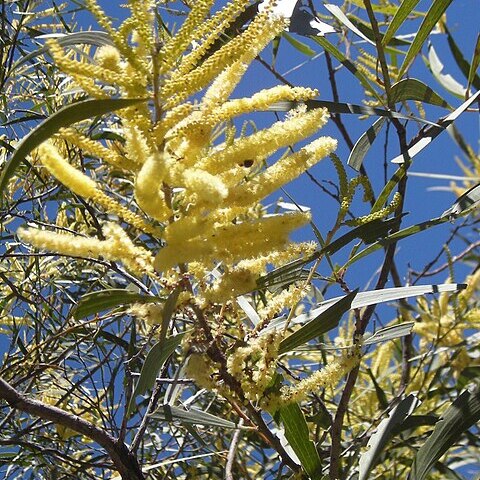Shrub or tree 2–8 (–15) m high; canopy blue-green. Bark smooth, or shallowly rimose on largest trees. Branchlets acutely angled for 10–25 cm (occasionally more) below apex, orange or green, glabrous. Phyllodes dimidiate (sometimes recurved at apex) to subfalcate, (3–) 5–12.5 cm long, 7–35 mm wide, thinly coriaceous, glaucous to subglaucous, glabrous; longitudinal veins numerous, 3 or 4 (–5) per mm, parallel and not anastomosing, with 3 main veins slightly raised (when dry), broader and more prominent than the rest, 3 or 4 less prominent secondary veins also present, with minor veins not raised; main nerves commonly confluent with lower margin for a short distance above pulvinus; pulvinus 4–8 (–10) mm long. Inflorescences simple, 1 or 2 (–4) per axil; peduncles (3–) 4–8 (–10) mm long; spikes 2–5 (–6) cm long, bright golden. Flowers 5‑merous; calyx gamosepalous, c. 0.5 mm long, shallowly dissected, ±glabrous; ovary glabrous. Pods narrowly oblong, sometimes twisted, straight to shallowly curved, 1.5–8 cm long, usually 0.8–1.5 cm wide, woody, resinous, glabrous, reddish brown, dehiscing along dorsal suture, strongly obliquely to ±longitudinally reticulately veined. Seeds oblique, ovate to oblong or elliptic, 3.5–5 mm long, brown to black; aril greyish cream.
A wattle. It is a shrub or low tree. It grows 2-8 m tall. The leaves are 6-7 cm long by 1-1.5 cm wide. They are covered with a white wax. They flowers are yellow and have a strong perfume. They are in spikes 15-20 mm long. The pods are 5 cm long by 1 cm wide. The seeds are 5 mm long by 2 mm wide.


